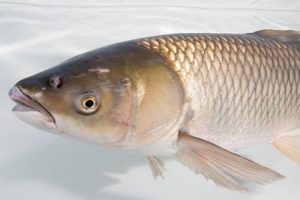Asian carp eggs, including late-stage embryos nearly ready to hatch from the egg, were identified in samples collected by U.S. Geological Survey scientists in 2013 from the Upper Mississippi River as far north as Lynxville, Wisc.
The eggs and late-stage embryos were 250 river miles upstream of previously known reproductive populations in the river. Spawning would have occurred upstream from this site.
The Asian carp eggs and late-stage embryos were discovered in while processing samples that were collected in mid-May and mid-June, 2013. The samples were taken as part of a larger research project designed to identify Asian carp spawning habitats.
Once the scientists visually identified the eggs, they examined other samples taken from the Mississippi River and found Asian carp eggs at seven locations between Pool 19 near Keokuk, Iowa, and Pool 9 of the main channel of the Upper Mississippi River near Lynxville. Iowa, Missouri, Illinois, Minnesota and Wisconsin border the navigation pools where these samples were collected.
The eggs and late-stage embryos were identified as bigheaded carps (either bighead carp or silver carp) through visual analyses of specific features of the eggs and embryos. It is also possible that some eggs could be from grass carp, although no eggs were visually identified as such.
The USGS attempted genetic analyses to definitively determine which species of Asian carp the eggs belong to, but the results were inconclusive. Additional steps are being completed to attempt genetic confirmation, and those results are expected in one to two weeks.
The research project that collected these eggs is being coordinated by the USGS in collaboration with Western Illinois University. Scientists plan to collect additional samples from the Mississippi River in 2014 as part of their on-going research project.
***UPDATE***
In 2014, USGS scientists tested fish eggs found in northern sections of the Upper Mississippi River and determined that the eggs and larvae were not from Asian carp.
Genetic analysis instead shows that the fish eggs collected in the summer of 2013 likely belong to a native North American species in the same family as carp.
All Asian carp species are considered invasive species and belong to the cyprinid fish family.
To confirm visual identification of the eggs’ species, scientists from the U.S. Geological Survey genetically tested 41 of the 65 eggs and larvae that were collected from Pool 9 and Pool 11 in the Upper Mississippi River in Wisconsin and Iowa.
DNA sequences successfully obtained from 17 eggs revealed that they were similar to those of other cyprinid fishes and did not come from Asian carp.
The one exception was an egg collected from Pool 19 in southern Iowa, which was genetically confirmed by the USGS as a grass carp, one of the four Asian carp species.
For more information on Asian carp research, please visit the Asian Carp Regional Coordinating Committee (ACRCC) website. The ACRCC is a partnership of federal and state agencies, municipalities and other groups, led by the White House Council on Environmental Quality.
source: U.S. Geological Survey
